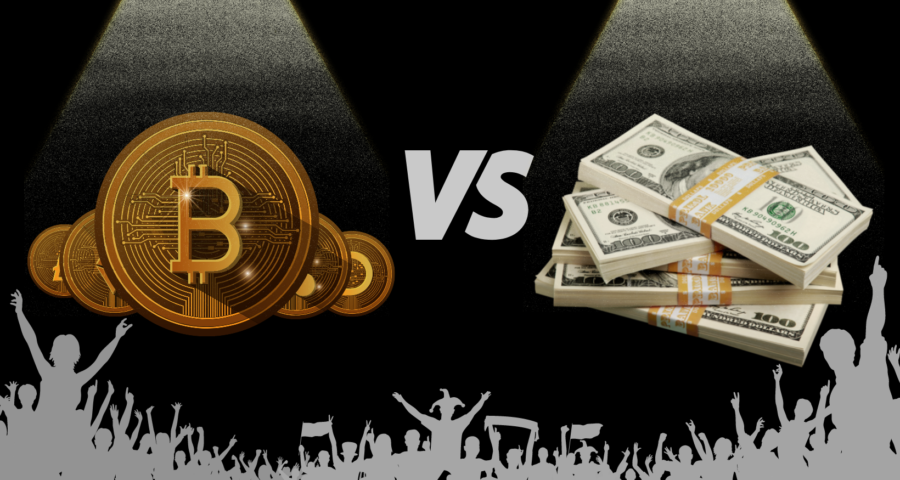The world is progressing quickly towards a cashless society. The world is also increasingly cautious about who they entrust their finances to. Cryptocurrencies are increasingly becoming popular and there are several reasons why.
With the government acting as a central authority, and with regulated financial institutions controlling our money, it has become somewhat of a norm to trust the banks and the central bodies.
However, history has repeatedly proven how fiat money can lead to crushing recessions and soaring inflations. 2008 is a prime example that shows how rigging our current system can translate to a worldwide financial disaster.
Another disturbing and possibly impending crisis resulting from the trillion dollar coin proposal (trillion dollar theory) is almost inevitable. This has made the public slowly sway towards a decentralized form of currency.
One that cannot be manipulated and one where each individual assumes full responsibility for their finances.
Key Differences between Fiat Money and Cryptocurrency
Anyone who begins the process of understanding cryptocurrencies would immediately realize that they simply don’t work like conventional fiat money.
Here’s how.
1. Inception
The government issues fiat currency taking into account the economy’s stability along with supply and demand for that currency. The central bank can hold or print more notes as and when needed.
Cryptocurrencies are created digitally using decentralized computing systems. Unlike fiat money, where one single entity controls, regulates, and prints money, cryptocurrencies are “mined” using a complex mathematical process.
2. Value
Fiat money does not hold value intrinsically. It is a piece of paper that has a symbolic value attached to it. The central authority determines its value. Some currencies are pegged to the USD making their values appreciate or depreciate based on the value of USD.
Cryptocurrencies also do not hold value intrinsically, because it is a 100% digital entity. However, the value of cryptos is collectively assigned based on a joint consensus by everyone in the network regardless of geographical location.
Therefore, the majority wins in the case of deciding a functional value for them.
3. Transaction
Fiat money is heavily regulated by banks and the government. This makes international transactions not just expensive but also relatively time consuming. Additionally, every transaction from A to B goes through these financial bodies.
Cryptocurrencies on the other hand are universally accepted. For example 1 Bitcoin(BTC) owned by someone in India is always equal to 1 BTC owned by someone in the United States. The idea is that you can use cryptocurrencies anywhere in the world as if it’s a local currency. As there are no intermediaries in between, transactions become significantly cheaper.
4. Supply
As mentioned above, fiat money is essentially printed according to the government’s discretion. Therefore, it’s limit is endless. Although there is currently a certain amount of notes in circulation, printing of new notes is not just inevitable, but also destructive.
Cryptocurrencies can be limited or unlimited depending on whether they have a limit programmed into them. Check out this link to find out the market cap of each cryptocurrency- Cryptocurrency Market Cap. The limited ones are those with a working progress bar.
Limited cryptocurrencies exist much like the total reserve of gold on our planet. For example, in the BTC blockchain, the system is created in such a way that there can only be 21 million BTCs ever to exist. Currently, a little shy of 19 million BTCs are in circulation and the remaining amount has to be “mined”, much like gold.
5. Tangibility
Paper notes and coins can be tangible, meaning they exist physically. This makes physical transfers easy along with digital and electronic transfers.
Cryptocurrencies only exist digitally, there is no physical tangibility. Therefore, only digital transfers are possible.
6. Representative
Fiat money exists in the form of paper notes and coins. Credit/debit cards are its electronic equivalent.
Cryptocurrencies are represented by a public key (one that can be shared around for transaction, much like your email address) and private keys which are meant to be held secure by the user (much like the password to access your email contents).
7. Storage
Fiat money is usually kept secure at financial institutions with the help of a bank account number.
Cryptocurrencies are stored in wallets that can exist both online and offline.
8. Transparency
Our financial system manages fiat money. However, what they do with that money, who they give out loans to, are some of the questions that cannot be easily uncovered because their operations are opaque.
The blockchain network records every single transaction that happens within it along with a time stamp. This ledger of transactions are visible to EVERYONE within the network.
The most revolutionary aspect of cryptocurrency is that it completely eliminates the need for a third party/intermediary for valuation, storage, control, and management of transactions. This is essentially giving the crypto owner full responsibility of managing his own dough.
Advantages of a Decentralized Financial System :-
- Free from the shackles of monetary policies that fiat currencies face. Any crisis associated with one currency and the following depreciation in the currencies pegged to it, can be avoided.
- Shield from bank failures, collapses, absconding, and unfavorable policies.
- International transactions become super cheap owing to cutting out the middlemen
- Foreign exchange rates do not apply here due to the universal acceptance of cryptocurrency
We have only seen the world move away from tangible forms of currency mainly because of convenience. We rarely carry cash or coins because almost all our transactions can happen using mobile apps.
Decentralized currencies, along with convenience, are gaining traction as a viable mode of payment due to the added benefit of being completely independent of the corrupt financial systems.
Companies like JP Morgan, Citi Group, and even Tesla are already speculating an increased demand for cryptocurrencies and simultaneously investing in them.
It’s only a matter of time before cryptocurrencies become a full blown necessity rather than it’s current worth as merely a speculative asset.


Leave a Reply